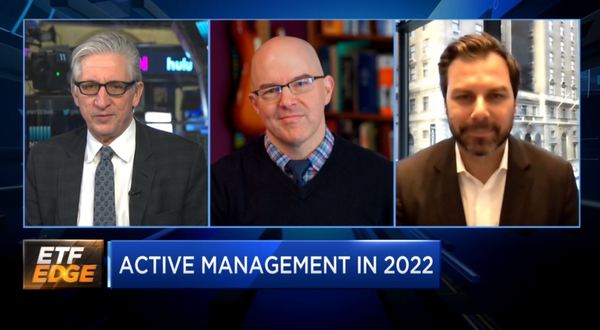Markets have been volatile for a couple months now, and with the turmoil and uncertainty being seen, it seems to be a great time for active management within mutual funds and ETFs. Dave Nadig, CIO and director of research at ETF Trends and ETF Database, and Bryon Lake, global head of ETF solutions for JPMorgan Asset Management, joined CNBC’s Bob Pisani on “ETF Edge” to discuss the role of active management in 2022.
So far, it’s been a great year for ETF flows, with ETFs bringing in between $13 and $14 billion in the last five trading sessions, but investors are diversifying their allocations primarily into internationally focused ETFs, Nadig explains. Roughly two-thirds of the flows so far have been into emerging and developed markets internationally, with domestic equities bringing in $4–$5 billion in the last five trading sessions.
“To me, that means that we’ve really had a raft of advisors and investors looking to buy the dip here. We’ve seen no evidence that the ETF side of the balance sheet, if you will, is what’s panicking and pushing the button to sell,” Nadig says.
The current volatility in the market will help foster increasing active ETF adoption by investors, and Nadig believes that active ETFs will continue to grow their market share, with the potential of hitting 15% this year. Volatility is something that is good for the story of active management, Nadig explains, and he thinks that active ETFs have a place for investors who are evaluating the corners of their portfolios.
Downside protection plays have seen a lot of flows in the last two years, whether it’s collar strategies, using puts or calls, or various combinations within equities. Also, mutual fund strategy conversions are happening at a faster rate, both conversions of existing mutual funds into ETF wrappers and ETF clones of mutual fund strategies. All of these provide more options and are bringing both more active managers and investors to the space.
“The active managers are here, they’re coming even faster than we expected, and I suspect this is going to be a big year for active flows,” Nadig says.
Lake explains that active ETFs right now are really a “best of both worlds” kind of scenario because they combine the benefits of ETF efficiency with the knowledge that active managers have of their portfolios.
The JPMorgan Equity Premium Income ETF (JEPI) is one of the classes of ETFs that provide investors with the ability to retain equity exposure with downside protection. JEPI is the fastest-growing active equity ETF and offers between 6%–9% in income stream, Lake says.
“Because of the way that the strategy is set up, it should only have about two-thirds of the risk of the S&P 500,” Lake explains. The fund accomplishes this by owning a basket of securities of U.S. equities and then writing calls on the holdings which provide a premium for the fund; this allows for both income and downside protection.

